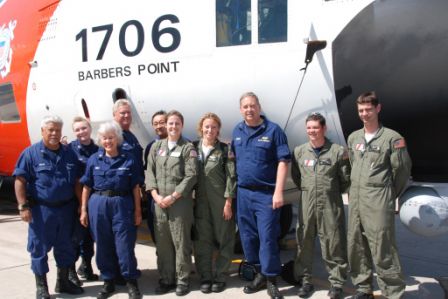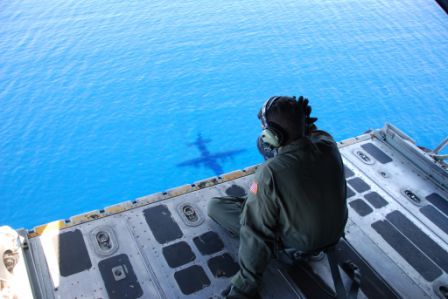

 |
|
Returning from flight: l to r, CGAUX 140-01-17 Blackie Kauwe, Richie Sweet, Skippy Sweet, and LJ Benson; CGAUX 140-01-14 Tony Ballesteros; USCG Barbers Point, LT Stephanie Kimmel, LT Heather Meineke; CGAUX 082-06-10 Mike Meineke; USCG Barbers Point, LCDR Al Hansen, AMT1 Mt Burgess. |
If you have been around the Auxiliary long enough, you have probably come to the realization that we spend most of our time either in training, or in practicing the skills we have learned. A recent trip to visit our daughter at Air Station Barber’s Point in Hawaii helped put things in the proper perspective.
While we were visiting, we were invited to participate in a training flight on a C-130 along with other Auxiliarists from the island who work with the Coast Guard. It turns out that our counterparts in the active Coast Guard spend much of their time doing the exact same thing, working together, training, and practicing so that when the call comes in they are ready.
To borrow some words from C-130 pilot LT Heather Meineke, “In Hawaii, the Auxiliarists, both air and boat crews, are a tremendous help.” The Air Auxiliary does a lot of Air Station Barber’s Point’s first light searches. If there was something reported during nighttime hours, say a flare, and nothing is found in the dark, the Coast Guard is required to do a search immediately after the sun comes up in the morning. When close to land, the Auxiliary will often complete the search, thus saving the Coast Guard a tremendous amount of money.
The boat crews help out a lot as well. They often help the C-130 crews with practicing drops. The main mission of the Coast Guard HC-130H assets is search and rescue. “Without a boat to practice dropping to, we would not have the ability to practice such a time-critical maneuver.” A half of a second on a drop can mean completely missing the vessel in a real scenario. Because of difference in seat height and seating position for each individual pilot, the pilots have to practice to find what works for each individual. “It is simply not something that can be simulated or studied out of a book. The Auxiliary provides us a platform to practice and perfect the drop maneuver.”
Lieutenant James Morrow, a C-130 pilot stationed at Air Station Clearwater, Florida, described his experience on a real search and rescue mission which helped to drive home these points, the importance of practice and training, and being ready.
Lieutenant Morrow was on a law enforcement patrol off the coast of Central America when they received a call for an urgent search and rescue case. “Well, when I thought it couldn't get any more REAL, it just did.” After learning they were being tasked with helping a 45-55 foot fishing vessel that was taking on water, they immediately initiated a climb and began heading in the direction they were instructed.
“We climbed up to altitude and started blasting over to the position that we were given.” Not knowing the gravity of the situation, the pilots instructed the Dropmaster and Loadmaster in the back of the plane to begin laying all of the search and rescue (SAR) gear out that they could possibly need for when they arrived on scene.
“It took us about 30 minutes of transit time to get out there and I'll never forget what we saw. It was pretty wild; we descended through the last cloud layer and then directly in front of us we could clearly make out the fishing vessel - almost all of it submerged in the water, significant oil sheen and tons of debris strewn about.”
They circled around the debris field, desperately looking for any survivors. On one pass, Lieutenant Morrow thought he saw a few orange life jackets together so he turned the plane around and descended to about 300' and found people waving their arms up at them. They immediately prepped for the drop of the MA-3 kit, which includes three life rafts and two waterproof survival equipment supply containers all connected by a total of 1000 feet of buoyant line.
The first thing they dropped was one 45-minute smoke flare in order to help evaluate the surface winds and followed that with two 18-minute flares to help with the timing of the drop. Knowing that they did not have a lot of daylight left, the crew in the back hurried to get the MA-3 kit prepared to drop. The pilots brought the plane around and lined up for a final approach to drop at around 200 feet above the water. “Needless to say, I was a little nervous at this point since it was my first actual drop to people who were clearly in a desperate situation,” Lieutenant Morrow continued to describe. “I passed by the first smoke and called out that we had 15 seconds to drop, made some fine tune adjustments for wind, passed by the last smoke, saw the people pass under my leg and called ‘DROP, DROP, DROP.’”
After the Dropmaster pushed the gear out the back on command, they added power and climbed up so they could turn around to see that the drop had been successful. “This is the most nerve racking part because the Dropmaster can kind of see how they did but it’s not until you make your first over-flight pass that you can really determine if it was a successful drop or not. We came back around and it looked beautiful!”
The rafts were lined up so that they were drifting directly towards the group of survivors. They watched one of the survivors climb aboard the raft and throw the line to the others. All seven eventually climbed aboard. During all of this maneuvering, the radio operator was communicating with a tanker vessel that was in the area and had asked the tanker to come pick up the seven people.
The crew on the C-130 circled overhead for a few hours while the tanker transited to their position. It took about an hour and a half because of the difficulty of moving such a large vessel around such small rafts but the tanker was eventually able to successfully recover all seven people and they were brought back to land safely.
Lieutenant Morrow and his crew had been training and practicing for literally hundreds of hours of flight time and years of training, but when that desperate call came in, they were ready and answered the call.
As Auxiliarists, we may never know how many lives that may have been saved among the people we have touched. It may be through the Auxiliary public education programs or through our constant training, either directly with the active Coast Guard or the training among our fellow Auxiliarists. But the fact is, that is why we train, and that’s why we practice. So that if or when that call comes in, we, too, are ready.
SEMPER PARATUS.
 |
|
The Dropmaster checks out the drop area. |
~mg 03-11-11